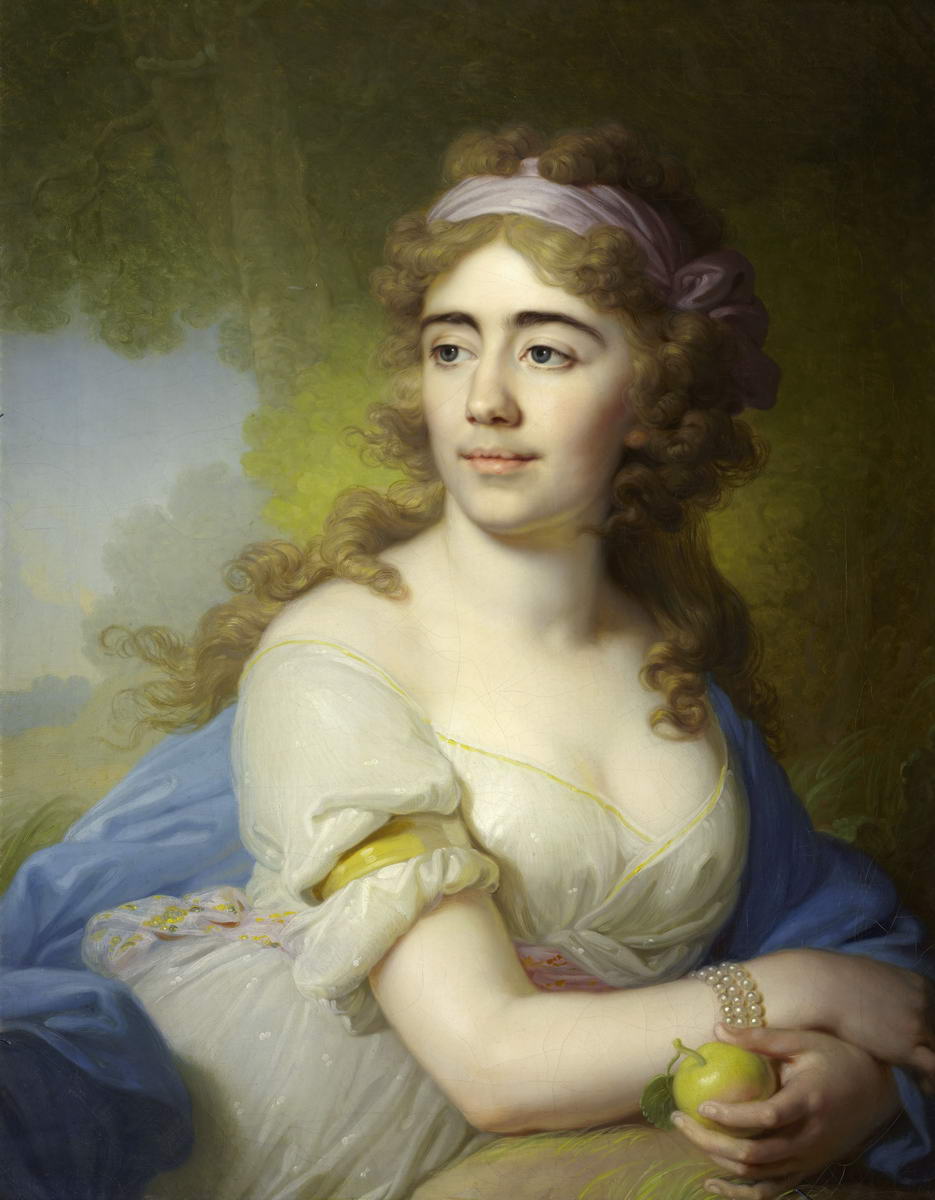


В конце ХVIII века Боровиковский создает целый ряд портретов (преимущественно женских) и утверждает в портретной живописи новый тип человека, "не сочиненный, а открытый только им" (портреты В. И. Арсеньевой, М. И. Лопухиной, Н. А. Нарышкиной, М. А. Орловой-Денисовой и др.). В портрете Скобеевой (имя, отчество неизвестно), как и в большинстве других, художник использовал свою уже сложившуюся композиционную схему: полуфигурная модель с явно выраженными портретными особенностями со скрещенными руками изображена в легком платье на фоне пейзажа. Открытое, с крупными чертами энергичное лицо выражает решительность и смелость, что вполне подтверждается фактами биографии портретируемой. Скобеева — дочь кронштадтского матроса, воспитанница и фаворитка Д. П. Трощинского, статс-секретаря Екатерины II. Существует версия, что, стремясь противостоять своему двусмысленному положению, девушка бежала от опекуна и вышла замуж за небогатого смоленского помещика Д. Скобеева. Возможно, в знак утверждения этого союза супруги захотели иметь портрет кисти самого модного тогда портретиста. Глава семейства заказал художнику два портрета своей жены: на лоне природы (данный портрет) и в образе недоступной Дианы (Скобеева в виде Дианы. Конец 1790-х. ГИМ. Вариант данного портрета меньшего размера).
Живописец-портретист.
Академик Императорской Академии художеств (с 1795), советник Академии (с 1802). Родился в Миргороде Полтавской губернии в семье казака. Учился у отца и дяди, занимавшихся иконописью. С 1788 жил в Петербурге, где совершенствовался под руководством Д. Г. Левицкого. С 1792 занимался у австрийского художника И. Б. Лампи, который впоследствии передал ему свою мастерскую. Был знаком с крупнейшими деятелями русской культуры своего времени: поэтом Г. Р. Державиным, писателем В. В. Капнистом, архитектором Н. А. Львовым. Автор многочисленных парадных портретов, а также камерных изображений современников, запечатленных им в непринужденной домашней обстановке или в естественном окружении. Известен как мастер миниатюрной живописи. Создал ряд икон для Казанского собора.

At the end of the eighteenth century Borovykovsky created a series of portraits (mostly female) and established in portrait painting a so-called new type of man, "not composed, but discovered only by him " (portraits of V.I.Arseneva, M.I.Lopuhina, N.A.Naryshkina , M.A.Orlova-Denisova, and etc.). In the portrait of Skobeeva (name and patronymic are unknown), as in most others, the artist has used his compositional scheme: “half-figure” model with distinctive portrait features is depicted with arms crossed in a light dress on the background of a landscape.
Open energetic face with large features expresses determination and courage. This impression is supported by the facts from biography of the heroine of the portrait. Skobeeva was the daughter of the Kronstadt sailor. She was a pupil and mistress of D.P. Troshchinsky, the State Secretary of Catherine II. There is a version that in an effort to confront her ambiguous position, the girl ran from a guardian and married a poor Smolensk landowner D. Skobeev.
Perhaps as a sign of approval of the union the spouses decided to have a portrait painted by the most fashionable portrait painter of those times. The head of the family ordered the artist two portraits of his wife: in the bosom of nature (the portrait) and the image of inaccessible Diana (Skobeeva as Diana. The end of the 1790s. The State Historical Museum. An embodiment of the portrait of smaller).
Painter, draughtsman, miniaturist, icon painter, portraitist. Born into a family of low rank Cossacks. Studied painting under his father, the icon painter Luke Borovik, in Mirgorod. Listed "above the specified number" in the Mirgorod regiment where his father and relatives served (1774). Awarded the rank of "comrade of the colours" (1783), resigned with the rank of lieutenant. Moved to St Petersburg (1788) and studied under Dmitry Levitsky and Johann Baptiste I Lampi. Nominated to the Imperial Academy of Arts (1794), academician of portrait painting (1795). Councillor of the Imperial Academy of Arts (1802). Contributed to the iconostasis of the Kazan Cathedralin St Petersburg (1804). Mason and member of Ekaterina Tatarinova''s mystical sect.



